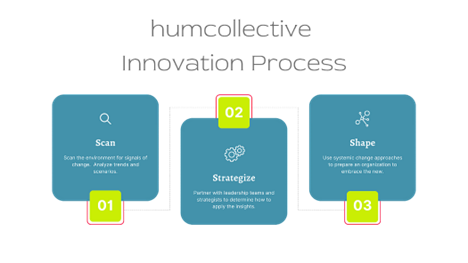Prepare for the Future with Foresight
Dr. Ciela Hartonov, a futurist, organizational psychologist, human behavior expert, writer, and thinker dedicated to reinventing work, shared this article as a companion to her podcast Prepare for the Future with Foresight.
Exploring the Future, Today
Anticipating, preparing for, and shaping the future is essential as the world continues to be more uncertain than ever. The best leaders and organizations recognize that they need to keep themselves educated and on top of emerging factors that may influence business longevity. The Vitality Index from BCG shows that organizations who are most resilient over the long run continuously develop future growth options, proactively anticipating how emergent change will impact them. To do this requires a comprehensive and strategic innovation approach.
Humcollective provides a systematic innovation approach that 1. Scans the environment for signals of change and impactful trends 2. Develops strategies to capitalize on opportunities or mitigate risks and 3. Embeds the shift into strategic organizational plans and change initiatives.
For the purposes of this article, the focus is on sharing more information about Step 1: Scan, which leverages foresight as the foundation. Foresight uses trending and forecasting tools to move beyond the known. It is designed to help us better understand future possibilities in order to build the strategic plans of tomorrow, today.
Collecting Inputs
Innovation comes from seeing what others do not yet see and making sense of patterns in a new way. Thus, the first step is scanning the environment for signals of change — the early warning signs of a shift underway. The process of identifying and analyzing signals allows us to anticipate the development of emerging trends. A cluster of signals indicates a trend is forming. By analyzing the trends, patterns and relationships that may not be immediately apparent are identified. It is important to look at both the macro and micro trends that may have an outsized impact on your industry to inform decision-making and planning.
Macro trends
Macro trends (sometimes called Drivers) have longer lasting periods of influence and are a pervasive and persistent shift at the global level, often in technology, economies or other influences on society at large. For example, an important trend in technology worth watching right now is Web3, a new iteration of the internet that is more decentralized and self-regulated. Let’s say we want to understand Web3 more deeply and how it might impact your industry. We would conduct a comprehensive process of monitoring and analyzing signals, events, and advances in Web3 that could indicate a potential change or opportunity. Through the systematic collection, analysis, and interpretation of information from a variety of sources, emerging patterns show how Web3 could impact an industry, organization or department.
Micro trends
Micro trends are faster acting and accelerate change. They give us quicker directional signals of what is changing and help us make sense of the macro trends. If we are exploring Web3 as an important technological driver, then we would look to micro trends in that area. For example, NFTs or the Metaverse, which are all part of the larger Web3 ecosystem but are having different impacts and show us different aspects of Web3’s impact.
Micro trend scanning comes from many places — first hand observations of human behavior, expert analysis and interviews, scanning communities of interest across the internet, varied and global news reports and many more. The result of this process is an organized collection of curated trends about your area of interest.
Making Sense of the Inputs
Once a trend collection has been completed, the information becomes valuable when it is turned into patterns and themes. At this stage, we begin to ask the question: What is all this telling us? This begins the process of understanding potential consequences of the emerging trends.
To start to make sense of the inputs, three dimensions are explored: Time, Impact, and Probability. By looking at the time horizon of the trend, the impact it could have across many dimensions (society, politics, business, etc.), and the level of certainty of its unfolding, a business can begin to map the most important issues now and over the long term.
Once you have scanned the environment by collecting inputs and made sense of them, you are ready to move to Steps 2 and 3 in the innovation Strategize and Shape. This is where scenarios for the future are developed and acted upon in the context of your business. While we are not exploring these steps in this article, you can learn more about the end-to-end innovation process by reading a case study about how Google used the process to reshape their learning agenda.
ABOUT THE AUTHOR:
Dr. Ciela Hartanov is a futurist, organizational psychologist, human behavior expert, writer, and thinker dedicated to reinventing work. She helps leaders create a revolution inside the modern workplace, one aimed at breaking a system that promotes work practices that have existed since the industrial era. She was part of the founding team of The Google School for Leaders and Head of Next Practice Innovation and Strategy at Google, where she developed projects designed to shape the future of leadership and work. She currently runs humcollective, a boutique strategy and innovation firm that helps companies, executives, and teams make sense of the forces shaping the future and prepare strategically.
RESOURCES:
Ready to measure your leadership skills? Complete your complimentary assessment through the Innovative Leadership Institute. Learn the 7 leadership skills required to succeed during disruption and innovation.
- Follow the Innovative Leadership Institute LinkedIn page
- Subscribe to Innovating Leadership and listen on your favorite podcast platform
- Subscribe to our blog – Insights
Check out the companion interview and past episodes of Innovating Leadership, Co-Creating Our Future via Apple Podcasts, TuneIn, Stitcher, Spotify, Amazon Music, Audible, iHeartRADIO, and NPR One.


Leave a Reply
Want to join the discussion?Feel free to contribute!